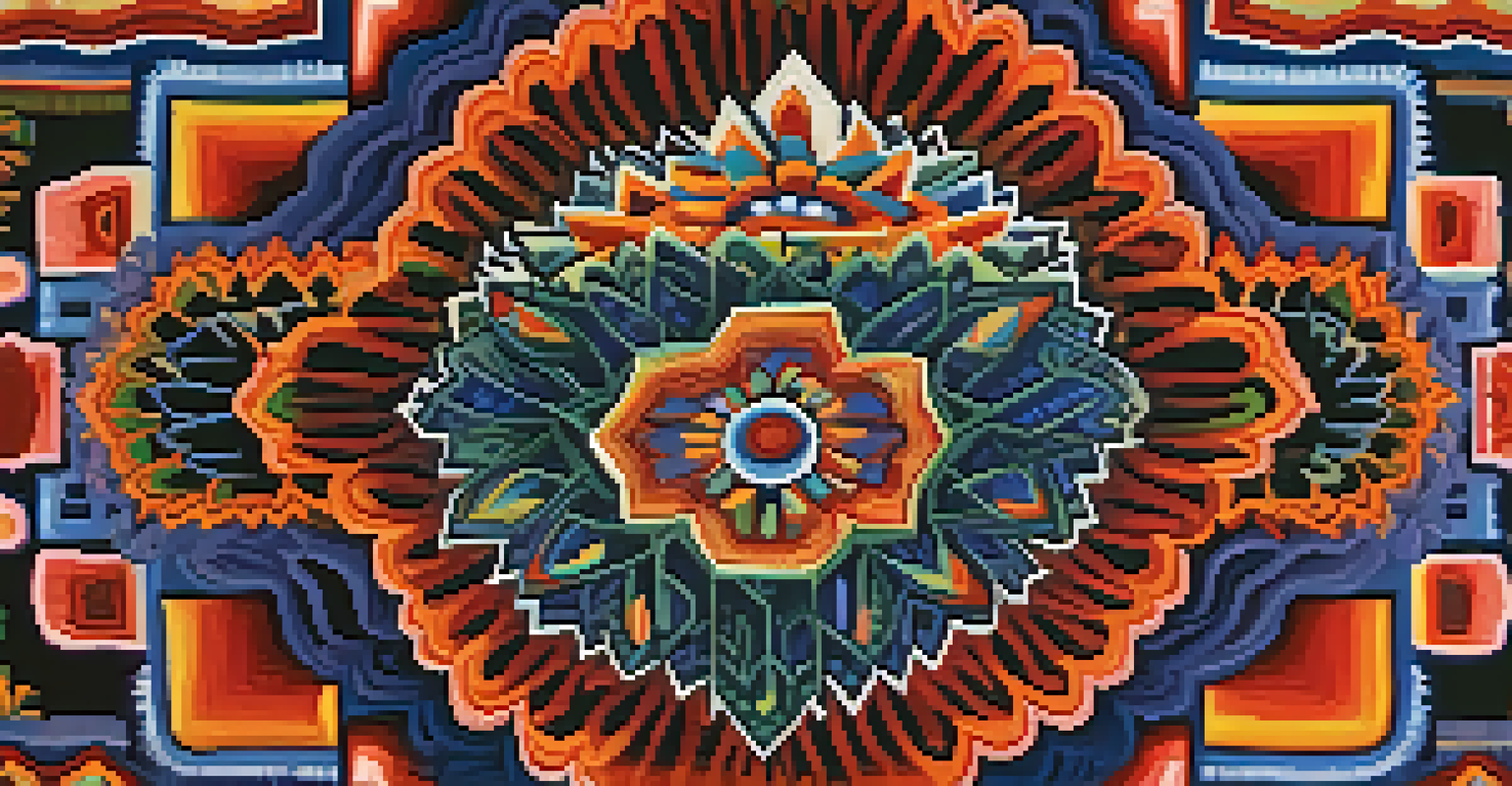Peyote and its Symbolism in Spiritual Traditions Worldwide

Understanding Peyote: A Sacred Cactus
Peyote, scientifically known as Lophophora williamsii, is a small, spineless cactus native to Mexico and the southwestern United States. It has been used for centuries by Indigenous peoples as a sacrament in spiritual ceremonies. Beyond its physical attributes, peyote is rich in symbolism, often seen as a bridge between the physical and spiritual realms.
The cactus is a bridge between the physical world and the spiritual realm, allowing individuals to connect deeply with their spirituality.
The cactus contains mescaline, a psychoactive compound that induces altered states of consciousness. For many, these experiences are profound and transformative, allowing individuals to connect deeply with their spirituality. This connection often leads to insights about life, nature, and the universe, making peyote a revered plant in various spiritual traditions.
From healing rituals to vision quests, peyote plays a central role in many ceremonies. It is not just a tool for intoxication; rather, it is considered a teacher, guiding users through their spiritual journeys. This deep-rooted connection to nature and the divine highlights the cactus's significance in Indigenous cultures.
Peyote in Native American Spirituality
In Native American spirituality, peyote is often associated with the Native American Church (NAC), which blends traditional practices with Christianity. Members of the NAC view peyote as a sacred sacrament that fosters spiritual growth and community bonding. Through collective ceremonies, individuals consume peyote to seek guidance and healing.

The rituals surrounding peyote involve prayer, singing, and drumming, creating a communal atmosphere that enhances the spiritual experience. Participants often report feelings of unity, love, and understanding during these ceremonies. This shared experience helps solidify cultural identity and reinforces the importance of the plant in their spiritual lives.
Peyote as a Sacred Plant
Peyote is revered in various Indigenous cultures as a sacrament that fosters spiritual growth and connection to the divine.
Moreover, peyote is seen as a symbol of resilience and survival for many Native American tribes. Despite historical efforts to suppress their traditions, these communities have preserved their sacred practices, ensuring that peyote remains a vital part of their spiritual heritage.
Peyote and Shamanic Practices
Shamanic traditions around the world often include the use of psychoactive plants, with peyote being a prominent choice in some cultures. Shamans, or spiritual healers, utilize peyote to enter altered states of consciousness, allowing them to communicate with spirits and gain insights for healing practices. This connection to the spirit world is crucial for guiding individuals through personal and communal challenges.
Peyote embodies the cyclical nature of life, representing transformation and renewal in both the physical and spiritual senses.
The symbolism of peyote in shamanism reflects a deep respect for nature and the interconnectedness of all living beings. Shamans believe that consuming peyote opens pathways to wisdom that can aid in healing both the physical body and the spirit. This profound understanding of the human experience underscores the importance of these rituals in many societies.
Additionally, peyote serves as a reminder of the balance between humanity and nature. Its use in shamanic practices emphasizes the need for respect and stewardship of the earth, as well as the sacredness of all life. By engaging with peyote, shamans and participants alike cultivate a sense of responsibility towards the environment.
Symbolism of Peyote in Mexican Culture
In Mexico, peyote is woven into the fabric of various cultural and spiritual practices, particularly among the Huichol and Tarahumara peoples. For these communities, peyote is not just a plant but a symbol of their relationship with the divine and the universe. The rituals surrounding its use often involve intricate art, storytelling, and vibrant ceremonies that celebrate life.
The Huichol, for instance, undertake pilgrimages to the sacred mountains where peyote grows. These journeys are seen as a rite of passage, filled with symbolic meaning as they connect with the spirit of the cactus. The vibrant colors and patterns found in their art often depict the spiritual journey, illustrating the significance of peyote in their worldview.
Cultural Resilience and Identity
For many Native American tribes, peyote symbolizes resilience and the preservation of cultural identity amidst historical challenges.
Moreover, peyote is associated with themes of fertility, renewal, and the cyclical nature of life. It embodies the idea of transformation, both physically and spiritually, as participants undergo profound experiences that can lead to personal growth. This rich symbolism highlights the deep appreciation and reverence these cultures have for peyote.
Peyote and Modern Spirituality Movements
In recent years, there has been a resurgence of interest in peyote among modern spiritual movements. As more individuals seek alternative paths for personal growth and healing, peyote's role has expanded beyond traditional practices. Many contemporary spiritual seekers view peyote as a powerful ally in exploring consciousness and enhancing their spiritual journeys.
These movements often emphasize the importance of respect for Indigenous cultures and their teachings. Many modern practitioners advocate for ethical sourcing and responsible use of peyote, recognizing its sacred status among Indigenous peoples. This respectful approach fosters a greater understanding of the plant's significance and promotes a more holistic view of spirituality.
Furthermore, the integration of peyote into modern spiritual practices raises important questions about cultural appropriation and the commodification of sacred traditions. As the dialogue continues, many advocates stress the need for collaboration and mutual respect between Indigenous communities and those seeking to understand peyote's symbolism and benefits.
Legal and Ethical Considerations of Peyote Use
The legal status of peyote varies widely around the world, often depending on cultural and religious contexts. In the United States, for example, peyote is protected under the American Indian Religious Freedom Act, allowing its use in traditional ceremonies. However, the legal landscape can be complex, raising important ethical questions about access and usage.
As interest in peyote grows, discussions around its conservation and sustainability have become increasingly relevant. Overharvesting and habitat loss threaten the survival of peyote, prompting many to advocate for responsible use and cultivation practices. This focus on sustainability is crucial to ensure that future generations can continue to engage with this sacred plant.
Modern Spirituality and Ethics
As interest in peyote grows among modern spiritual seekers, discussions around ethical use and respect for Indigenous traditions are becoming increasingly important.
Additionally, the ethical implications of non-Indigenous use of peyote cannot be overlooked. Many Indigenous communities urge respect for their traditions and knowledge, emphasizing that peyote is more than just a plant; it embodies their cultural identity and spiritual teachings. Acknowledging these complexities is vital for fostering meaningful connections with peyote.
The Future of Peyote in Spiritual Practices
As society continues to evolve, the future of peyote in spiritual practices remains a topic of interest and exploration. With increasing awareness of mental health and the potential therapeutic benefits of psychedelics, more individuals are looking towards peyote as a means of healing and personal growth. This shift brings both opportunities and challenges for the cultural preservation of peyote traditions.
Many advocates for the future of peyote stress the importance of education and dialogue between cultures. By fostering understanding and respect, there is potential for collaboration that honors the sacred nature of peyote and its role in various traditions. This approach can help bridge the gap between Indigenous and contemporary practices, creating a richer tapestry of spiritual exploration.

Ultimately, the future of peyote lies in a delicate balance between honoring its traditional roots and embracing its potential for personal and collective transformation. As more people engage with peyote, the conversations around its symbolism, ethics, and sustainability will continue to shape its place in the spiritual landscape.